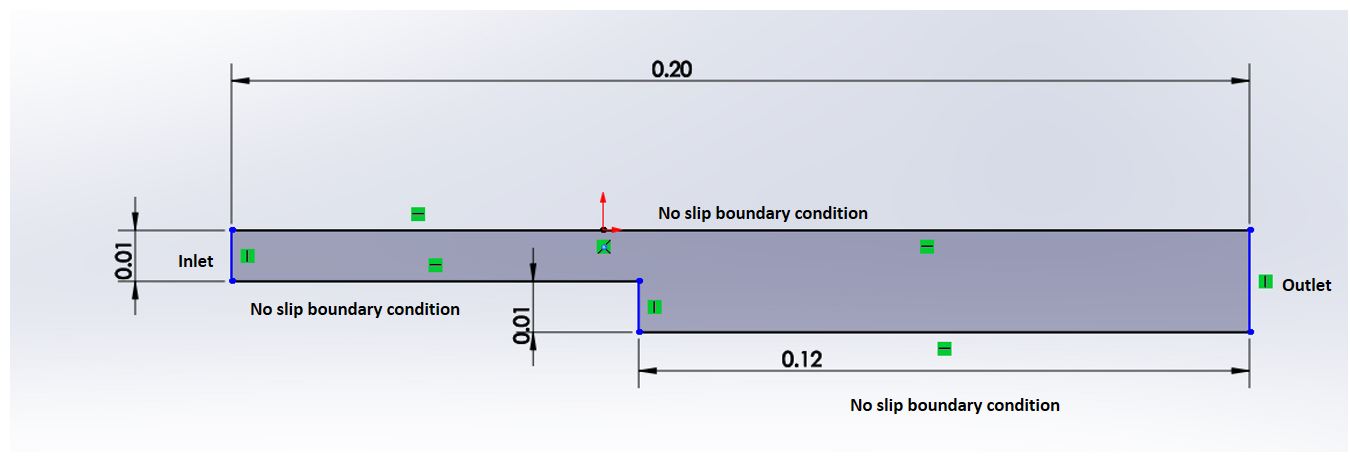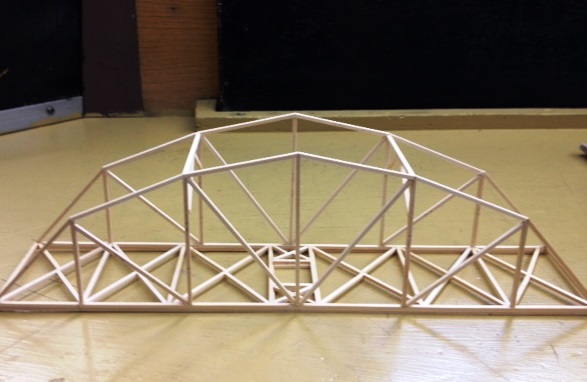Courses by Software
Courses by Semester
Courses by Domain
Tool-focused Courses
Machine learning
POPULAR COURSES
Success Stories
Week 8 - BlockMesh Drill down challenge
AIM-to create a BlockMesh and to simulate it . OBJECTIVES:- How does the velocity magnitude profile change as a function of mesh grading factor. Use factors, 0.2, 0.5,0.8 Measure the velocity profile at 0.085 m from the inlet of the geometry Plot must be a line plot Compare velocity magnitude contours near the step region…
Mainak Bhowmick
updated on 15 Oct 2020
AIM-to create a BlockMesh and to simulate it .
OBJECTIVES:-
- How does the velocity magnitude profile change as a function of mesh grading factor. Use factors, 0.2, 0.5,0.8
- Measure the velocity profile at 0.085 m from the inlet of the geometry
- Plot must be a line plot
- Compare velocity magnitude contours near the step region for the above mentioned grading factors.
SOME INPUTS:-
- Number of cells along the x direction (longer dimension) = 200
- Number of cells along the y direction = 10
- Use a graded mesh. Grading factor near all walls should be 0.2
PROBLEM

OPENFOAM
Openfoam is a opensource software,it is the free, open source CFD software developed by openFoamCFD limited since 2004. It has a large user base across most areas of engineering and science, from both commercial and academic organisations. OpenFOAM has an extensive range of features to solve anything from complex fluid flows involving chemical reactions, turbulence and heat transfer, to acoustics, solid mechanics and electromagnetics.
ABOUT THE SOLVER
icoFoam solves the incompressible laminar Navier-Stokes equations using the PISO algorithm. The code is inherently transient, requiring an initial condition (such as zero velocity) and boundary conditions. The icoFOAM code can take mesh non-orthogonality into account with successive non-orthogonality iterations. The number of PISO corrections and non-orthogonality corrections are controlled through user input.
BLOCKMESH
/*--------------------------------*- C++ -*----------------------------------*\
========= |
\\ / F ield | OpenFOAM: The Open Source CFD Toolbox
\\ / O peration | Website: https://openfoam.org
\\ / A nd | Version: 8
\\/ M anipulation |
\*---------------------------------------------------------------------------*/
FoamFile
{
version 2.0;
format ascii;
class dictionary;
object blockMeshDict;
}
// * * * * * * * * * * * * * * * * * * * * * * * * * * * * * * * * * * * * * //
convertToMeters 0.001;
vertices
(
(0 0 0)//0
(80 0 0)//1
(80 5 0)//2
(0 5 0)//3
(80 10 0)//4
(0 10 0)//5
(200 10 0)//6
(200 5 0)//7
(200 0 0)//8
(200 -10 0)//9
(80 -10 0)//10
(0 0 1)//11
(80 0 1)//12
(80 5 1)//13
(0 5 1)//14
(80 10 1)//15
(0 10 1)//16
(200 10 1)//17
(200 5 1)//18
(200 0 1)//19
(200 -10 1)//20
(80 -10 1)//21
);
blocks
(
hex (0 1 2 3 11 12 13 14) (200 10 1) simpleGrading (1 5 1)
hex (3 2 4 5 14 13 15 16) (200 10 1) simpleGrading (1 0.2 1)
hex (2 7 6 4 13 18 17 15) (200 10 1) simpleGrading (5 0.2 1)
hex (1 8 7 2 12 19 18 13) (200 10 1) simpleGrading (5 5 1)
hex (10 9 8 1 21 20 19 12) (200 10 1) simpleGrading (5 5 1)
);
edges
(
);
boundary
(
inlet
{
type patch;
faces
(
(0 11 14 3)
(3 14 16 5)
);
}
outlet
{
type patch;
faces
(
(9 8 19 20)
(8 7 18 19)
(7 6 17 18)
);
}
fixedWalls
{
type wall;
faces
(
(4 5 16 15)
(6 4 15 17)
(11 0 12 1)
(21 10 9 20)
(12 1 10 21)
);
}
frontAndBack
{
type empty;
faces
(
(11 12 13 14)
(14 13 15 16)
(13 18 17 15)
(12 19 18 13)
(21 20 19 12)
(1 0 3 2)
(2 3 5 4)
(2 4 6 7)
(1 2 7 8)
(1 8 9 10)
);
}
);
mergePatchPairs
(
);
// ************************************************************************* //
CONTROL DICT FILE
/*--------------------------------*- C++ -*----------------------------------*\
========= |
\\ / F ield | OpenFOAM: The Open Source CFD Toolbox
\\ / O peration | Website: https://openfoam.org
\\ / A nd | Version: 8
\\/ M anipulation |
\*---------------------------------------------------------------------------*/
FoamFile
{
version 2.0;
format ascii;
class dictionary;
location "system";
object controlDict;
}
// * * * * * * * * * * * * * * * * * * * * * * * * * * * * * * * * * * * * * //
application icoFoam;
startFrom startTime;
startTime 0;
stopAt endTime;
endTime 0.5;
deltaT 0.0001;
writeControl timeStep;
writeInterval 20;
purgeWrite 0;
writeFormat ascii;
writePrecision 6;
writeCompression off;
timeFormat general;
timePrecision 6;
runTimeModifiable true;
// ************************************************************************* //
INITIAL PRESSURE
/*--------------------------------*- C++ -*----------------------------------*\
========= |
\\ / F ield | OpenFOAM: The Open Source CFD Toolbox
\\ / O peration | Website: https://openfoam.org
\\ / A nd | Version: 8
\\/ M anipulation |
\*---------------------------------------------------------------------------*/
FoamFile
{
version 2.0;
format ascii;
class volScalarField;
object p;
}
// * * * * * * * * * * * * * * * * * * * * * * * * * * * * * * * * * * * * * //
dimensions [0 2 -2 0 0 0 0];
internalField uniform 0;
boundaryField
{
inlet
{
type zeroGradient;
}
outlet
{
type fixedValue;
value uniform 0;
}
fixedWalls
{
type zeroGradient;
}
frontAndBack
{
type empty;
}
}
// ************************************************************************* //INITIAL VELOCITY
/*--------------------------------*- C++ -*----------------------------------*\
========= |
\\ / F ield | OpenFOAM: The Open Source CFD Toolbox
\\ / O peration | Website: https://openfoam.org
\\ / A nd | Version: 8
\\/ M anipulation |
\*---------------------------------------------------------------------------*/
FoamFile
{
version 2.0;
format ascii;
class volVectorField;
object U;
}
// * * * * * * * * * * * * * * * * * * * * * * * * * * * * * * * * * * * * * //
dimensions [0 1 -1 0 0 0 0];
internalField uniform (0 0 0);
boundaryField
{
inlet
{
type fixedValue;
value uniform (1 0 0);
}
outlet
{
type zeroGradient;
}
fixedWalls
{
type noSlip;
value uniform (0 0 0);
}
frontAndBack
{
type empty;
}
}
// ************************************************************************* //MESHGRADING FACTOR 0.2
(
hex (0 1 2 3 11 12 13 14) (200 10 1) simpleGrading (1 2 1)
hex (3 2 4 5 14 13 15 16) (200 10 1) simpleGrading (1 0.5 1)
hex (2 7 6 4 13 18 17 15) (200 10 1) simpleGrading (2 0.5 1)
hex (1 8 7 2 12 19 18 13) (200 10 1) simpleGrading (2 2 1)
hex (10 9 8 1 21 20 19 12) (200 10 1) simpleGrading (2 2 1)
);



MESHING FACTOR AT 0.2

MESHGRADING FACTOR 0.5
(
hex (0 1 2 3 11 12 13 14) (200 10 1) simpleGrading (1 5 1)
hex (3 2 4 5 14 13 15 16) (200 10 1) simpleGrading (1 0.2 1)
hex (2 7 6 4 13 18 17 15) (200 10 1) simpleGrading (5 0.2 1)
hex (1 8 7 2 12 19 18 13) (200 10 1) simpleGrading (5 5 1)
hex (10 9 8 1 21 20 19 12) (200 10 1) simpleGrading (5 5 1)
);



MESHGRADING FACTOR 0.8
(
hex (0 1 2 3 11 12 13 14) (200 10 1) simpleGrading (1 1.25 1)
hex (3 2 4 5 14 13 15 16) (200 10 1) simpleGrading (1 0.8 1)
hex (2 7 6 4 13 18 17 15) (200 10 1) simpleGrading (1.25 0.8 1)
hex (1 8 7 2 12 19 18 13) (200 10 1) simpleGrading (1.25 1.25 1)
hex (10 9 8 1 21 20 19 12) (200 10 1) simpleGrading (1.25 1.25 1)
);

MESH GRADING 0.8

CONCLUSION
- From the above results the results cannot be differentiated , but from the database it is observed that
U(0.2)=0.372729
U(0.5)=0.373843
U(0.8)=0.379172
at a distance of 0.085 from the starting point.
- The time taken for simulating 0.2 is the least.
Thus we conclude lower meshgrading size better is the accuracy.
Leave a comment
Thanks for choosing to leave a comment. Please keep in mind that all the comments are moderated as per our comment policy, and your email will not be published for privacy reasons. Please leave a personal & meaningful conversation.
Other comments...
Be the first to add a comment
Read more Projects by Mainak Bhowmick (6)
Week 11 - Simulation of Flow through a pipe in OpenFoam
AIM- Write a program in Matlab that can generate the computational mesh automatically for any wedge angle and grading schemes For a baseline mesh, show that the velocity profile matches with the Hagen poiseuille's equation Show that the velocity profile is fully developed Post process velocity and shear stress…
29 Oct 2020 06:38 PM IST
Week 9 - FVM Literature Review
FINITE VOLUME METHOD - The finite volume is a discretisation method which is well suited for numerical simulations of various types namely hyperbolic, elliptic and parabolic for instance of conservation laws. It has been extensively used in several engineering fields, such as fluid mechanics, heat and mass transfer or…
20 Oct 2020 10:43 AM IST
Week 8 - BlockMesh Drill down challenge
AIM-to create a BlockMesh and to simulate it . OBJECTIVES:- How does the velocity magnitude profile change as a function of mesh grading factor. Use factors, 0.2, 0.5,0.8 Measure the velocity profile at 0.085 m from the inlet of the geometry Plot must be a line plot Compare velocity magnitude contours near the step region…
15 Oct 2020 09:58 AM IST
Week 7 - Simulation of a 1D Super-sonic nozzle flow simulation using Macormack Method
AIM- Simulation of 1D supersonic nozzle flow simulation using Macormack method OBJECTIVES- 1. Steady-state distribution of primitive variables inside the nozzle2. Time-wise variation of the primitive variables3. Variation of Mass flow rate distribution inside the nozzle at different time steps during the time-marching…
30 Sep 2020 08:16 PM IST
Related Courses






0 Hours of Content

Skill-Lync offers industry relevant advanced engineering courses for engineering students by partnering with industry experts.
Our Company
4th Floor, BLOCK-B, Velachery - Tambaram Main Rd, Ram Nagar South, Madipakkam, Chennai, Tamil Nadu 600042.
Top Individual Courses
Top PG Programs
Skill-Lync Plus
Trending Blogs
© 2025 Skill-Lync Inc. All Rights Reserved.








